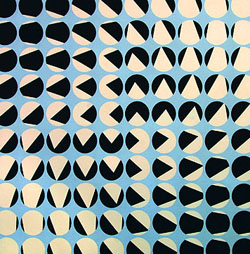05.26.2006 13:04
 25 May 2006 - 25 July 2006
25 May 2006 - 25 July 2006
On 25 May 2006 an exhibition opened in the Halls near the Saltykov Entrance of the Winter Palace presenting circa 50 works of the main representatives of Kineticism from various countries around the world: Italy, Latin America, France, Yugoslavia, Russia and Germany.
The exhibition was organized by the State Hermitage together with Il Cigno Galileo Galilei publishing house, with support from the Ministry of Foreign Affairs of Italy, the Ministry of Culture of Italy and the General Consulate of Italy in St Petersburg.
Kinetic Art or Kineticism is an art genre based on the idea of form in motion. It is understood not as the physical movement of an object from one place to another, but as its change or transformation, as any form of "life" of an object at the moment it is perceived by a spectator. Some works are dynamically transformed by the viewer himself, while others by variations in the surrounding air. There was widespread use of constructions put in motion by a motor or electromagnetic force. In many instances the illusion of movement arises thanks to changing illumination. Sometimes the shape is changed optically as the spectator’s observation point is changed.
Kinetic Art grew as an independent art movement in the second half of the 1950s. It was preceded by the experiments of Dadaists, Futurists and Constructivists, as well as by the ideas of creating works with changing shape that were in the air at the time. The main tasks which the Kineticist artists set for themselves are to give aesthetic quality to motion, the play of light and shadow when using nontraditional transparent materials, experiments with dynamics and chiaroscuro. With the help of special structures they create the illusion of motion. One additional device which is frequently used by the artists is to create the so called “moire effect” which arises from the interaction of several grids or matrices positioned at a certain distance from each other. Any movement by the viewer turns on the mechanism of interaction of the matrix grids, leading to the formation of complex shimmering ornamental images.
Very impressive works result from using contrasting linear structures when an integral image is constituted from a real wave-shaped drawing. The compositions themselves evoke in the viewer a wide range of graphic associations. Often the perception shifts between flat images to three-dimensional and back again.
One further special feature of Kinetic Art is its rational aesthetic and the geometric, strictly calculated shape of objects, the programmed movement of form and light.
The objective of the exhibition is to trace the development of this art movement, directing attention firstly to the art of postwar Italy, where contributions to Kineticism were made by Brugo Munari, the Milan "Gruppa T" and, to a large extent, "Gruppa H" from the Veneto region. Among those who were part of the latter were Alberto Biazi, Manfredo Massironi, Toni Costa and Edoardo Landi - all of whom were young artists taking shape in the mid-1950’s.
The oeuvre of Albero Biasi, one of the most exquisite and complex representatives of Kineticism, is associated with mastery of mechanisms of optical recognition directed to search for analogies with natural phenomena. This art is intended to draw the spectator into special interrelationships.
Later, during the G.R.A.V. (Group of Research of the Visual Arts) was formed in France during the 1960s by the artists Demarco, Garcia Rossi, Porelle, Sobrino and Le Parc, who received the first prize at the Biennale in Venice in 1968.
Russia also did not remain on the sidelines. Among those who took part in the artistic experiments one can name the group "Movement" (Dvizhenie), which included Nusberg, Koleichuk, and Urin, as well as the group "Peace" (Mir), founded by Koleichuk and Rygunov. Among works by Russian artists on display in the exhibition are those by Koleichuk, Infante and Stuchebriukov.
The curator of the exhibition is Alexei K. Mitin, researcher in the State Hermitage’s Department of Western European Art.
News source: hermitagemuseum.org
 Print this news Print this news
Culture news archive for 26 May' 2006.
Culture news archive for May' 2006.
Culture news archive for 2006 year.
|